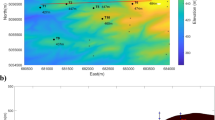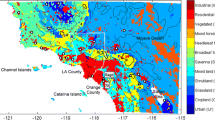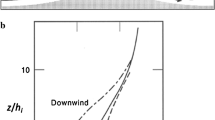Abstract
Mesoscale models which can be used to assess wind and turbulent structure in complex terrain are overviewed. The different types of models — diagnostic and prognostic are discussed and the significant physical processes which each can handle realistically are reviewed. Examples of specific applications of these models are presented.
Similar content being viewed by others
References
Anthes, R. A. and Warner, T. T.: 1978, ‘Development of Hydrodynamic Models Suitable for Air Pollution and Other Mesometeorological Studies’, Monthly Weather Rev., 106, 1045–1078.
Bader, D. C. and McKee, T. B.: 1983, ‘Dynamical Model Simulation of the Morning Boundary Layer Development in Deep Mountain Valleys’, J. Clin. Appl. Meteorol., 22, 341–351.
Bell, R. A.: 1978, ‘The Forecasting of Geographically Enhanced Rainfall Accumulations Using 10-Level Model Data’, Meteorol. Mag., 107, 113–124.
Carpenter, K.: 1979, ‘An Experimental Forecast Using a Nonhydrostatic Mesoscale Model’, Quart. J. Roy. Meteorol. Soc., 105, 629–655.
Clark, T. L. and Gall, R.: 1982, ‘Three-Dimensional Numerical Model Simulations of Airflow Over Moutainous Terrain: A Comparison with Observations’, Monthly Weather Rev., 110, 766–791.
Collier, C. G.: 1975, ‘A Representation of the Effects of Topography on Surface Rainfall Within Moving Baroclinic Disturbances’, Quart. J. Roy. Meteorol. Soc., 103, 247–253.
Collier, C. G.: 1977, ‘The Effect of Model Grid Length and Orographic Rainfall Efficiency on Computed Surface Rainfall’, Quart. J. Roy. Meteorol. Soc., 103, 247–253.
Danard, M.: 1977, ‘A Simple Model for Mesoscale Effects of Topography on Surface Winds’, Monthly Weather Rev., 105, 572–581.
Defant F.: 1951, Local Winds, Compendium of Meteorology pp. 655–672. A. Meteorol. Soc., Boston, Massachusetts.
Dickerson, M. H.: 1978, ‘MASCON — A Mass-Consistent Atmospheric Flux Model for Regions with Complex Terrain’, J. Appl. Meteorol., 17, 241–253.
Fosberg, M. A., Marlatt, W. E., and Krupnak, L.: 1976, ‘Estimating Airflow Patterns over Complex Terrain’, U.S., For. Serv., Rocky Mtn. For. Range Exp. Stn., Res. Pap. RM-162, pp. 1–16.
Garstang, M., Pielke, R. A., and Snow, J. W.: 1980, ‘A Comparison of Model Predicted to Observed Winds in the Coastal Zone’, Contract Report for the Battelle Northwest Laboratory, Department of Energy.
Højstrup, J.: 1981, ‘A Simple Model for the Adjustment of Velocity Spectra in Unstable Conditions Downstream of an Abrupt Change in Roughness and Heat Flux’, Boundary Layer Meteorol., 21, 341–356.
Hsu, H.-M.: 1979, ‘Numerical Simulations of Mesoscale Precipitation Systems’, Ph.D. Dissertation, Dept. Atmos. Oceanic Sci., University of Michigan, Ann Arbor.
Kikuchi, Y., Arakawa, S., Kimura, F., Shirasaki, K., and Nagano, Y.: 1981, ‘Numerical Study on the Effects of Mountains on the Land and Sea Breeze Circulation in the Kanto District’, J. Meteorol. Soc. Japan, 59, 723–738.
Klemp, J. B. and Lilly, D. K.: 1975, ‘The Dynamics of Wave-Induced Downslope Winds’, J. Atmos. Sci., 32, 320–339.
Lavoie, R. L.: 1972, ‘A Mesoscale Numerical Model of Lake-Effect Storms’, J. Atmos. Sci., 29, 1025–1040.
Mahrer, Y. and Pielke, R. A.: 1976, ‘The Numerical Simulation of the Airflow over Barbados’, Monthly Weather Rev., 104, 1392–1402.
Martin, C.: 1981, ‘Numerical Accuracy in a Mesoscale Meteorological Model’, M.S. Thesis, Dept. Environ. Sci., Univ. of Virginia.
McNider, R. T.: 1981, ‘Investigation of the Impact of Topographic Circulations on the Transport and Dispersion of Air Pollutants’, Ph.D. Dissertation, University of Virginia, Dept. of Environmental Sciences, Charlottesville, Virginia.
McNider, R. T. and Pielke, R. A.: 1984, ‘Numerical Simulation of Slope and Mountain Flows’, J. Appl. Meteorol. (in press).
McPherson, R. D.: 1970, ‘A Numerical Study of the Effect of a Coastal Irregularity on the Sea Breeze’, J. Appl. Meteorol., 9, 767–777.
Namias, J.: 1983, ‘The History of Polar Front and Air Mass Concepts in the United States - An Eyewitness Account’, Bull. Amer. Meteorol. Soc., 64, 734–755.
Panofsky, H. A., Larko, D., Lipschutz, R., and Stone, G.: 1981, ‘Spectra over Complex Terrain’, Preprint, 4th U.S. National Conf. on Wind Engineering Research, Seattle, Washington, D.C., July 26–29, 1981.
Panofsky, H. A., Larko, D., Lipschutz, R., Stone, G., Bradley, E. F., Bowen, A. J., and Højstrup, J.: 1982, ‘Specta of Velocity Components Over Complex Terrain’, Quart. J. Roy. Meteorol. Soc., 108, pp. 215–230.
Patnack, P. C., Freeman, B. E., Traci, R. M., and Phillips, G. T.: 1983, ‘Improved Simulations of Mesoscale Meteorology’, Report Atmospheric Science Laboratory, White Sands Missile Range, NM, ASL CR-83-0127-1.
Pielke, R. A.: 1974, ‘A Three-Dimensional Numerical Model of the Sea Breezes over South Florida’, Monthly Weather Rev., 102, 115–139.
Pielke, R. A.: 1984a, ‘Mesoscale Meteorological Modelling’, Academic Press, 612 pp.
Pielke, R. A.: 1984b, ‘Mesoscale Dynamics: Thermal and Orographic Mesoscale Atmospheric Systems — An Essay’, Chapter in The Joe Smagorinsky Volume, Academic Press (in press).
Pielke, R. A. and Mahrer, Y.: 1978, ‘Verification Analysis of the University of Virginia Three-Dimensional Mesoscale Model Prediction over South Florida for July 1, 1973’, Monthly Weather Rev., 106, 1568–1589.
Rhea, O. J.: 1977, ‘Orographic Precipitation Model for Hydrometeorological Use’, Ph.D. Dissertation, Dept. of Atmos. Sci., Colorado State Univ., Fort Collins, Colorado.
Seaman, N. L.: 1982, ‘A Numerical Simulation of Three-Dimensional Mesoscale Flows over Mountainous Terrain’, University of Wyoming, Dept. of Atmospheric Science, Report No. AS 135 under NSF Grant No. ATM-77-17540, 86 pp.
Segal, M., Mahrer, Y., and Pielke, R. A.: 1981, ‘Numerical Study of Wind Energy Characteristics over Heterogeneous Terrain — Central Israel Case Study’, Boundary-Layer Meteorol., 22, 373–392.
Segal, M., Mahrer, Y., and Pielke, R. A.: 1982, ‘Application of a Numerical Mesoscale Model for the Evaluation of Seasonal Persistent Regional Climatological Patterns’, J. Appl. Meteorol., 21, 1754–1762.
Segal, M., Mahrer, Y., and Pielke, R. A.: 1983, ‘A Numerical Model Study of Meteorological Patterns Associated with a Lake Confined by Mountains — The Dead Sea Case’, Quart. J. Roy. Meteorol. Soc., 109, 549–564.
Sherman, C. E.: 1978, ‘A Mass-Consistent Model for Wind Fields over Complex Terrain’, J. Appl. Meteorol., 17, 312–319.
Smith, R. B.: 1979, ‘The Influence of Mountains on the Atmosphere’, in Adv. Geophys., 21, 87–230.
Snow, J. W.: 1981, ‘Wind Power Assessment Along the Atlantic and Gulf Coasts of the U.S.’, Ph.D. Dissertation, Dept. of Environmental Sciences, University of Virginia, Charlottesville.
Warner, T. J., Anthes, R. A., and McNab, A. L.: 1978, ‘Numerical Simulations with a Three-Dimensional Mesoscale Model’, Monthly Weather Rev., 106, 1079–1099.
Whiteman, C. D.: 1981, ‘Temperature Inversion Buildup in Valleys of the Rocky Mountains’, Second Conference on Mountain Meteorology, Steamboat Springs, CO. Am. Meteorol. Soc., Boston, MA.
Whiteman, C. D.: 1982, ‘Breakup of Temperature Inversions in Deep Mountain Valleys: Part I. Observations’, J. Appl. Meteorol., 21, pp. 270–289.
Young, G. S. and Pielke, R. A.: 1983, ‘Application of Terrain Height Variance Spectra to Mesoscale Modeling’, J. Atmos. Sci., 40, 2555–2560.
Author information
Authors and Affiliations
Rights and permissions
About this article
Cite this article
Pielke, R.A. The use of mesoscale numerical models to assess wind distribution and boundary-layer structure in complex terrain. Boundary-Layer Meteorol 31, 217–231 (1985). https://doi.org/10.1007/BF00120893
Received:
Issue Date:
DOI: https://doi.org/10.1007/BF00120893




